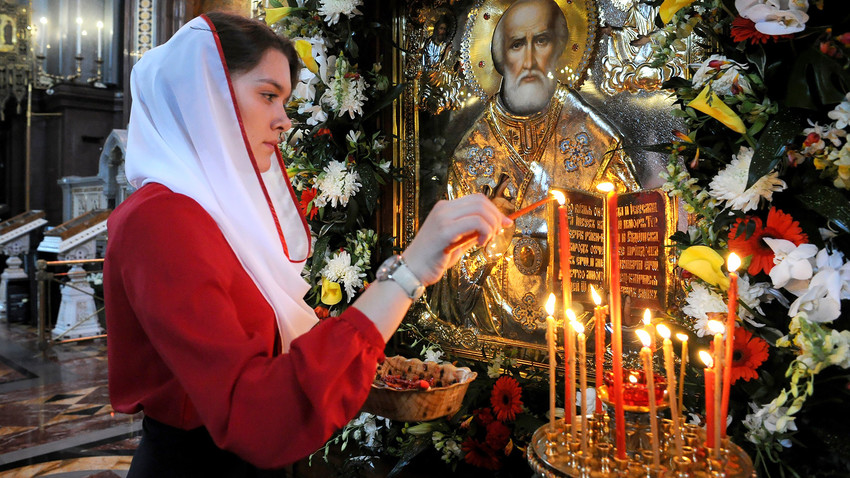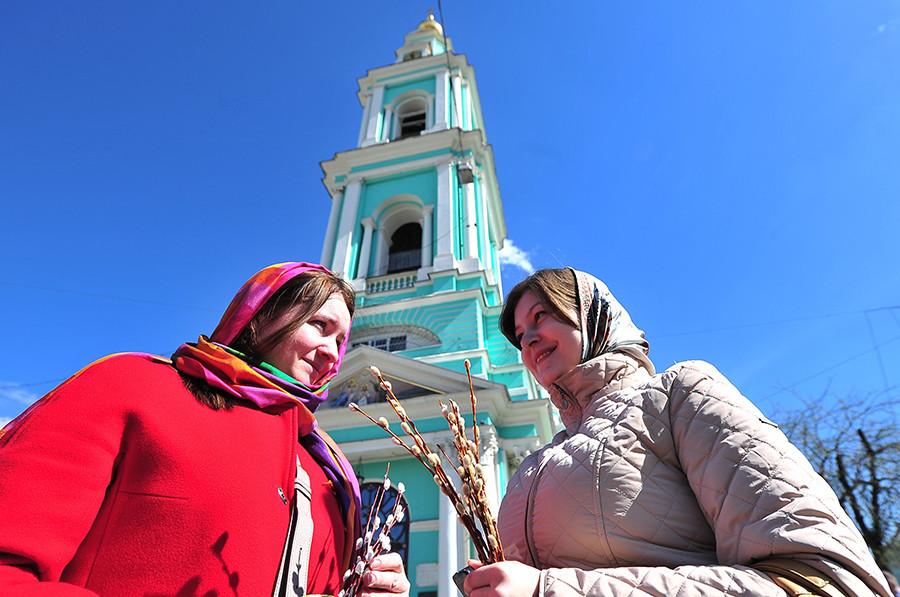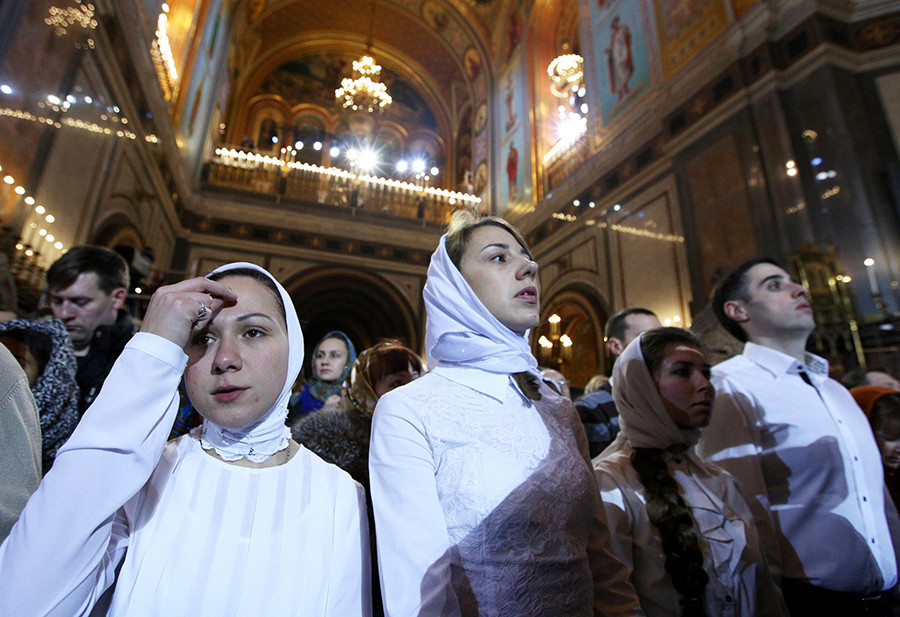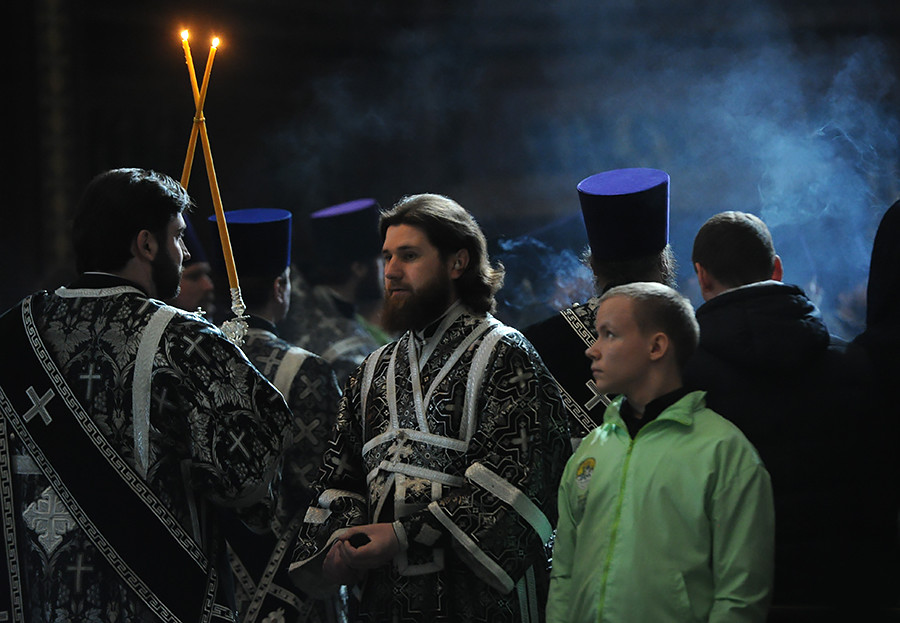How to behave in a Russian Orthodox church

There are some rules that one should know before visiting
Andrey Lyubimov/ Moskva AgencyDo not quarrel with believers
The first thing a visitor should know when he or she is inside an Orthodox church is that you shouldn’t irritate the parishioners. Even if you know you’re right and they are not. For example, there is no official ban on taking photographs inside a church, but this is something that can distract or annoy the churchgoers (especially if you use a flash or if everyone hears the typical sounds of the shutter). Someone can order you to put the camera/phone away. Be respectful. The worst thing is to start arguing. Do not forget that in Russia there is a law on offending the rights of believers.

There is no official ban on taking photographs inside a church, but this is something that can distract or annoy the churchgoers.
Sergey Kiselev/ Moskva AgencyDress appropriately
If you are a man, remove your hat before entering the church. Women usually cover their heads with a veil.
Actually, according to canon law, the veil concerns only married women since it symbolizes the husband’s power over his wife. But the original symbolism has been forgotten and now everyone covers their heads: Women, young ladies, and girls.
Women should also not enter the church in revealing clothing and bright makeup. And when visiting convents, women should wear long skirts.
Enter the church correctly
If you are a tourist and have come to the church solely out of curiosity, then enter calmly. But if you want to look like a real Orthodox believer, then you should know the following:
Firstly, before entering the church, cross yourself and bow three times. You have to put the first three fingers together and touch your forehead, then your stomach, then the right shoulder and the left. Cross yourself again after you’re inside.
A common mistake is crossing yourself and bowing simultaneously. You should bow in between the crossing. Your mistake might be noticed and it’s possible a churchgoer may come over and give you some instructions.

A common mistake is crossing yourself and bowing simultaneously.
Kirill Zykov/ Moskva AgencyDo not speak on the phone
It is better to switch your phone off altogether or at least turn off the sound. It is customary to remain silent in the church. Whispering is acceptable, but only when necessary. If your ringtone violates the church’s silence, it is really bad. All the praying babushkas will look at you with disapproval.
Move about gracefully
Do not run, recite your own sermons, stage performances (remember Pussy Riot?) or play Pokemon Go.
Walk slowly inside the church. During

Do not run, recite your own sermons, stage performances (remember Pussy Riot?) or play Pokemon Go.
Andrey Lyubimov/ Moskva AgencyThe altar is a forbidden spot
The altar is the space that is blocked off by the iconostasis wall: It is categorically forbidden to go there. The same goes for the
You should also not turn your back to the altar. Churchgoers usually turn around lightly and slowly move towards the exit. But hardly anyone follows this rule since it is rather difficult to walk out this way.
Light a candle
As a rule, each saint has his “sphere of responsibility.” Those who pray for health, light a candle to the Mother of God, the Savior or St. Pantaleon. John the Revelator is the patron of creativity. Students light candles to Sergius of Radonezh before exams. And those who pray for repose light a candle to the Crucifix, which is always by the entrance.
And don’t eat
If you see food on a stand in the church, this is not a buffet for the churchgoers. It can be prosphora (liturgical bread), but it’s only for those who have received communion. Many churches also collect food and then give it out to needy parishioners.
Obviously, you must also not eat food that you bring with you.
Actually, Russia is a multi-confessional country, but most of its citizens (75 percent, according to surveys) are Orthodox Christians. Read more about it here.
If using any of Russia Beyond's content, partly or in full, always provide an active hyperlink to the original material.
Subscribe
to our newsletter!
Get the week's best stories straight to your inbox